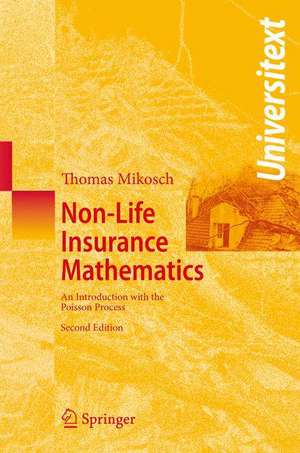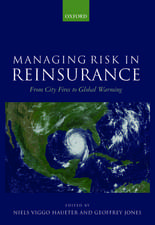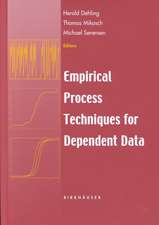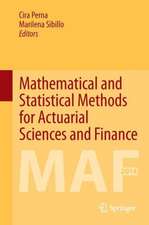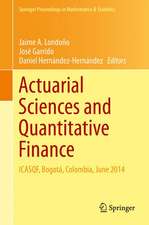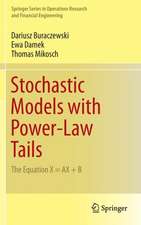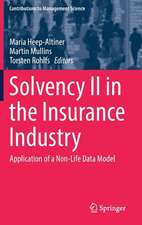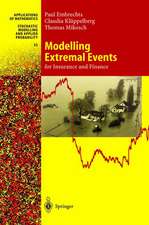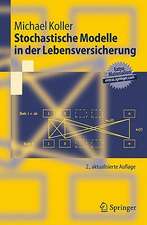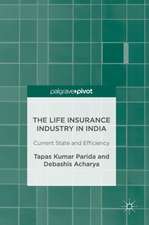Non-Life Insurance Mathematics: An Introduction with the Poisson Process: Universitext
Autor Thomas Mikoschen Limba Engleză Paperback – 25 mar 2009
Din seria Universitext
- 13%
 Preț: 353.49 lei
Preț: 353.49 lei -
 Preț: 487.96 lei
Preț: 487.96 lei - 15%
 Preț: 543.75 lei
Preț: 543.75 lei -
 Preț: 418.67 lei
Preț: 418.67 lei - 20%
 Preț: 628.22 lei
Preț: 628.22 lei -
 Preț: 322.62 lei
Preț: 322.62 lei - 17%
 Preț: 364.82 lei
Preț: 364.82 lei -
 Preț: 634.38 lei
Preț: 634.38 lei - 17%
 Preț: 427.32 lei
Preț: 427.32 lei - 13%
 Preț: 355.52 lei
Preț: 355.52 lei - 17%
 Preț: 431.50 lei
Preț: 431.50 lei - 19%
 Preț: 429.21 lei
Preț: 429.21 lei - 19%
 Preț: 393.81 lei
Preț: 393.81 lei -
 Preț: 360.08 lei
Preț: 360.08 lei -
 Preț: 358.44 lei
Preț: 358.44 lei - 13%
 Preț: 389.95 lei
Preț: 389.95 lei -
 Preț: 465.61 lei
Preț: 465.61 lei -
 Preț: 371.99 lei
Preț: 371.99 lei - 15%
 Preț: 497.22 lei
Preț: 497.22 lei - 15%
 Preț: 737.46 lei
Preț: 737.46 lei - 17%
 Preț: 394.41 lei
Preț: 394.41 lei - 15%
 Preț: 509.58 lei
Preț: 509.58 lei - 17%
 Preț: 427.68 lei
Preț: 427.68 lei - 8%
 Preț: 495.44 lei
Preț: 495.44 lei - 17%
 Preț: 364.57 lei
Preț: 364.57 lei - 17%
 Preț: 368.15 lei
Preț: 368.15 lei -
 Preț: 396.55 lei
Preț: 396.55 lei - 15%
 Preț: 553.33 lei
Preț: 553.33 lei - 17%
 Preț: 365.35 lei
Preț: 365.35 lei -
 Preț: 356.78 lei
Preț: 356.78 lei -
 Preț: 673.45 lei
Preț: 673.45 lei - 17%
 Preț: 426.76 lei
Preț: 426.76 lei - 20%
 Preț: 569.56 lei
Preț: 569.56 lei -
 Preț: 372.87 lei
Preț: 372.87 lei -
 Preț: 319.07 lei
Preț: 319.07 lei -
 Preț: 379.86 lei
Preț: 379.86 lei -
 Preț: 445.88 lei
Preț: 445.88 lei -
 Preț: 382.36 lei
Preț: 382.36 lei - 15%
 Preț: 533.72 lei
Preț: 533.72 lei - 15%
 Preț: 496.02 lei
Preț: 496.02 lei - 15%
 Preț: 474.82 lei
Preț: 474.82 lei -
 Preț: 389.70 lei
Preț: 389.70 lei -
 Preț: 484.08 lei
Preț: 484.08 lei - 15%
 Preț: 643.48 lei
Preț: 643.48 lei -
 Preț: 415.02 lei
Preț: 415.02 lei - 15%
 Preț: 602.25 lei
Preț: 602.25 lei - 20%
 Preț: 510.24 lei
Preț: 510.24 lei - 15%
 Preț: 588.37 lei
Preț: 588.37 lei -
 Preț: 381.59 lei
Preț: 381.59 lei
Preț: 507.95 lei
Preț vechi: 597.59 lei
-15% Nou
Puncte Express: 762
Preț estimativ în valută:
97.21€ • 101.11$ • 80.25£
97.21€ • 101.11$ • 80.25£
Carte tipărită la comandă
Livrare economică 14-28 aprilie
Preluare comenzi: 021 569.72.76
Specificații
ISBN-13: 9783540882329
ISBN-10: 3540882324
Pagini: 448
Ilustrații: XV, 432 p. 55 illus.
Dimensiuni: 155 x 235 x 30 mm
Greutate: 0.66 kg
Ediția:2nd ed. 2009
Editura: Springer Berlin, Heidelberg
Colecția Springer
Seria Universitext
Locul publicării:Berlin, Heidelberg, Germany
ISBN-10: 3540882324
Pagini: 448
Ilustrații: XV, 432 p. 55 illus.
Dimensiuni: 155 x 235 x 30 mm
Greutate: 0.66 kg
Ediția:2nd ed. 2009
Editura: Springer Berlin, Heidelberg
Colecția Springer
Seria Universitext
Locul publicării:Berlin, Heidelberg, Germany
Public țintă
GraduateCuprins
Collective Risk Models.- The Basic Model.- Models for the Claim Number Process.- The Total Claim Amount.- Ruin Theory.- Experience Rating.- Bayes Estimation.- Linear Bayes Estimation.- A Point Process Approach to Collective Risk Theory.- The General Poisson Process.- Poisson Random Measures in Collective Risk Theory.- Weak Convergence of Point Processes.- Special Topics.- An Excursion to L#x00E9;vy Processes.- Cluster Point Processes.
Recenzii
From the reviews:
"The book offers a mathematical introduction to non-life insurance and, at the same time, to a multitude of applied stochastic processes. It gives detailed discussions of the fundamental models for claim sizes, claim arrivals, the total claim amount, and their probabilistic properties. … The reader gets to know how the underlying probabilistic structures allow one to determine premiums in a portfolio or in an individual policy. Special emphasis is given to the phenomena which are caused by large claims in these models." (Zentralblatt für Didaktik der Mathematik, November, 2004)
"The author’s aim to bring some of the standard stochastic models of non-life insurance mathematics to the attention of a wide audience … can definitely be reached by this textbook. It is well-written … . Many figures and tables in this book help in illustrating and visualizing the developed theory. Moreover, every section ends with an extensive collection of exercises… and should help the reader in accessing the theory." (Josef Steinebach, Zentralblatt MATH, Vol. 1033 (8), 2004)
From the reviews of the second edition:
"The brief summary of the book’s contents and purpose … describes it as a mathematical introduction to non-life insurance, and it introduces the appropriate range of stochastic processes for this purpose. … The book is based upon lectures given to 3rd year mathematics students … . this book is suited to study at the advanced undergraduate level at the earliest. Overall, this is a fascinating book on a subject … ." (P. N. Ruane, The Mathematical Association of America, August, 2009)
"The book contains both basic and more advanced material on non-life insurance mathematics. … aim at the undergraduate actuarical students. … can serve as an independent course on stochastic models of non-life insurance mathematics at the graduate level." (Alexandra Rodkina, Zentralblatt MATH, Vol. 1166, 2009)
"The book offers a mathematical introduction to non-life insurance and, at the same time, to a multitude of applied stochastic processes. It gives detailed discussions of the fundamental models for claim sizes, claim arrivals, the total claim amount, and their probabilistic properties. … The reader gets to know how the underlying probabilistic structures allow one to determine premiums in a portfolio or in an individual policy. Special emphasis is given to the phenomena which are caused by large claims in these models." (Zentralblatt für Didaktik der Mathematik, November, 2004)
"The author’s aim to bring some of the standard stochastic models of non-life insurance mathematics to the attention of a wide audience … can definitely be reached by this textbook. It is well-written … . Many figures and tables in this book help in illustrating and visualizing the developed theory. Moreover, every section ends with an extensive collection of exercises… and should help the reader in accessing the theory." (Josef Steinebach, Zentralblatt MATH, Vol. 1033 (8), 2004)
From the reviews of the second edition:
"The brief summary of the book’s contents and purpose … describes it as a mathematical introduction to non-life insurance, and it introduces the appropriate range of stochastic processes for this purpose. … The book is based upon lectures given to 3rd year mathematics students … . this book is suited to study at the advanced undergraduate level at the earliest. Overall, this is a fascinating book on a subject … ." (P. N. Ruane, The Mathematical Association of America, August, 2009)
"The book contains both basic and more advanced material on non-life insurance mathematics. … aim at the undergraduate actuarical students. … can serve as an independent course on stochastic models of non-life insurance mathematics at the graduate level." (Alexandra Rodkina, Zentralblatt MATH, Vol. 1166, 2009)
Notă biografică
Thomas Mikosch has been professor at the Laboratory of Actuarial Mathematics of the University of Copenhagen since January 2001. Before this, he held positions in Dresden (Germany), Wellington (New Zealand) and Groningen (Netherlands). His special interests are applied probability theory and stochastic processes. Over the last few years his research has focused on extremal events in finance, insurance and telecommunications. His earlier very successful book, written jointly with Paul Embrechts and Claudia Klüppelberg, Modelling Extremal Events for Finance and Insurance (1997), is also published by Springer.
Textul de pe ultima copertă
The volume offers a mathematical introduction to non-life insurance and, at the same time, to a multitude of applied stochastic processes. It includes detailed discussions of the fundamental models regarding claim sizes, claim arrivals, the total claim amount, and their probabilistic properties. Throughout the volume the language of stochastic processes is used for describing the dynamics of an insurance portfolio in claim size, space and time. Special emphasis is given to the phenomena which are caused by large claims in these models. The reader learns how the underlying probabilistic structures allow determining premiums in a portfolio or in an individual policy.
The second edition contains various new chapters that illustrate the use of point process techniques in non-life insurance mathematics. Poisson processes play a central role. Detailed discussions show how Poisson processes can be used to describe complex aspects in an insurance business such as delays in reporting, the settlement of claims and claims reserving. Also the chain ladder method is explained in detail.
More than 150 figures and tables illustrate and visualize the theory. Every section ends with numerous exercises. An extensive bibliography, annotated with various comments sections with references to more advanced relevant literature, makes the volume broadly and easily accessible.
The second edition contains various new chapters that illustrate the use of point process techniques in non-life insurance mathematics. Poisson processes play a central role. Detailed discussions show how Poisson processes can be used to describe complex aspects in an insurance business such as delays in reporting, the settlement of claims and claims reserving. Also the chain ladder method is explained in detail.
More than 150 figures and tables illustrate and visualize the theory. Every section ends with numerous exercises. An extensive bibliography, annotated with various comments sections with references to more advanced relevant literature, makes the volume broadly and easily accessible.
Caracteristici
Rigorous mathematical introduction and as such quite a unique textbook which can be used not only by a specialised audience More than 100 figures and tables illustrating and visualizing the theory Every section ends with extensive exercises Book's content is in agreement with the European “Group Consultatif” standards An extensive bibliography, annotated by various comments sections with references to more advanced relevant literature, make the book broadly and easily accessible Includes supplementary material: sn.pub/extras
